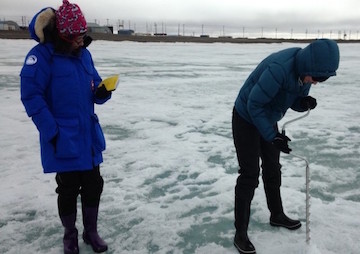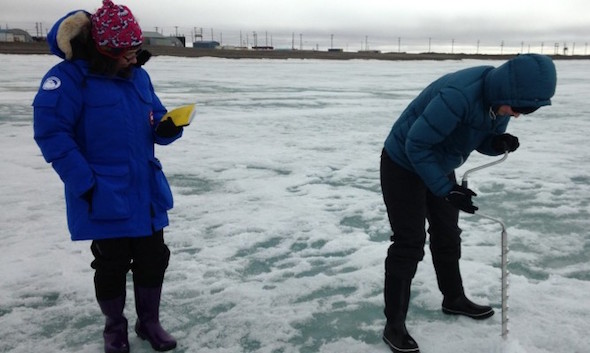Arctic Ice Dwindles to Record Low
Twelve months of global record-high temperatures have led to this month’s Arctic sea ice shrinking to almost 400,000 square miles less than four years ago, scientists find.
By Tim Radford / Climate News Network

Researchers drill into the sea ice off Barrow, Alaska, to record its thickness. (W Meier / NASA)
This piece first appeared at Climate News Network.
LONDON — The cover of frozen water in the Arctic last month fell to more than 580,000 square kilometres below the previous record for May, set in 2004.
And the US National Snow and Ice Data Centre (NSDIC) reports that the sea ice was also a full million square kilometres [about 386,000 square miles] less than May 2012 — the year that, in September, recorded the lowest-ever summer extent.
The record low follows a series of record temperatures globally. The warmest February and March since global records were first kept was followed by the warmest-ever April.
Not only was April the warmest on record, it was the twelfth consecutive month in which all temperature records for that month had been broken, according to the US National Oceanic and Atmospheric Administration.
Reduced thickness
Polar scientists are not surprised. Chris Rapley, professor of climate science at University College London and a former director of the British Antarctic Survey, says: “Temperatures in the Arctic over the last winter have been running as much as 10°C above the 1981-2010 average, and are still 2°-3°C higher.
“For a short period in December, sea ice at the North Pole was at or close to melting, with temperatures at least 20°C above normal. Not surprisingly, the Arctic ice and snow cover are responding with record low extents.
“The current rate of sea ice loss, and the reduced thickness of large areas of the ice remaining, suggests that we may see yet another record minimum in summer sea ice extent this year.”
“The region is undergoing warming at around
twice the global average, and the ice
is responding accordingly.”
The loss of sea ice can only have knock-on effects for Arctic creatures, such as polar bears, which cross onto the sea ice to hunt for their favoured prey, seals. But Professor Rapley warns that the change is also a problem for humans.
He says: “The impacts on the Arctic ocean and land systems are transformational, creating huge problems for the circum-Arctic peoples who, on the basis of their traditional knowledge, confirm that the high latitude climate system has already shifted well outside the bounds they have previously experienced.
“The situation is important for us, as the reduced temperature gradient between the equator and the North Pole is changing the circulation patterns and behaviours of the atmosphere and oceans, contributing to our direct experience of climate disruption.”
Polar scientists report that, overall, northern sea ice is not just lower in extent but is thinner as well.
Spring melt
Scientists who made coring tests off Barrow in Alaska — which recorded the earliest ever spring melt in 78 years of record-keeping — report that where they would have expected thicknesses of up to 150 centimetres, they were recording depths of only 80 to 100 cm.
The Northern hemisphere as a whole had “exceptionally low” snow cover for April and May of this year, and the count for the three spring months of March, April and May was the lowest in 50 years of observation by Rutgers University Snow Lab.
Jonathan Bamber, director of the Bristol Glaciology Centre at the University of Bristol, UK, says: “We have already seen an unusually early start to melting around the margins of Greenland in 2016 and the new findings from NSIDC of exceptionally low sea ice extent for May and the lowest Northern Hemisphere snow cover in April for 50 years is in line with the longer-term, decadal trends for the Arctic as a whole,” said
“The region is undergoing warming at around twice the global average, and the ice is responding accordingly.”
Tim Radford, a founding editor of Climate News Network, worked for The Guardian for 32 years, for most of that time as science editor. He has been covering climate change since 1988.
Your support matters…Independent journalism is under threat and overshadowed by heavily funded mainstream media.
You can help level the playing field. Become a member.
Your tax-deductible contribution keeps us digging beneath the headlines to give you thought-provoking, investigative reporting and analysis that unearths what's really happening- without compromise.
Give today to support our courageous, independent journalists.






You need to be a supporter to comment.
There are currently no responses to this article.
Be the first to respond.